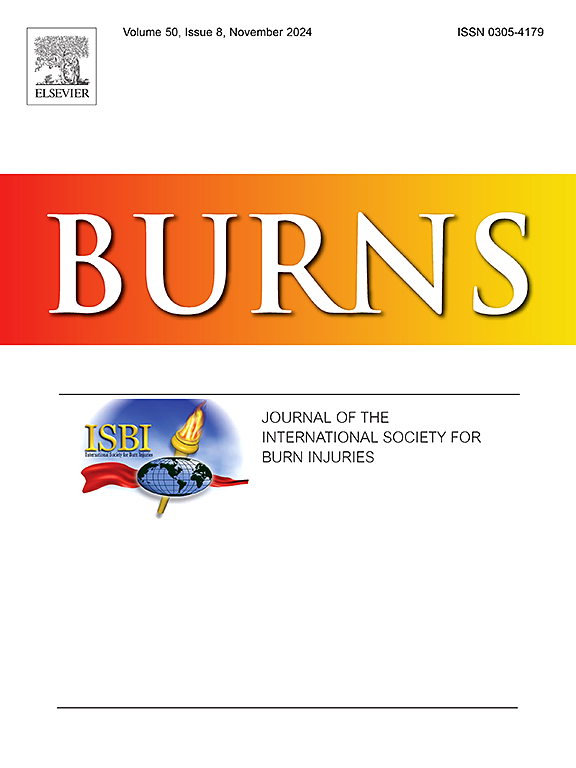将 Suprathel® 和水过滤红外线辐射(wIRA)作为治疗中毒性表皮坏死(TEN)的新策略:前瞻性研究。
IF 2.9
3区 医学
Q2 CRITICAL CARE MEDICINE
引用次数: 0
摘要
中毒性表皮坏死(TEN)是一种危及生命的疾病,死亡率约为 25% 至 30%。由于皮肤缺损面积较大,因此必须及早进行充分的伤口覆盖。Suprathel® 是一种现代伤口敷料,在治疗烫伤、烧伤和擦伤等浅表伤口时显示出良好的效果。之前关于使用 Suprathel® 对 TEN 患者进行伤口护理的报告中,描述了在使用 Suprathel® 之前对整个患处体表进行彻底清创的情况。但是,TEN 伤口分泌物较多,可能导致 Suprathel® 的大部分随时间流失。手术时间延长会增加体温过低的风险。此外,大面积的开放性伤口会增加低血容量性休克、伤口感染和随后的败血症风险。本研究提出了一种新策略,即对伤口进行连续的水疗清创,并在患处逐步使用 Suprathel®。使用水过滤红外线 A 光 (wIRA) 使覆盖 Suprathel® 的区域保持干燥。我们收集了接受聚己内酯凝胶治疗的患者(对照组 1)和只接受 Suprathel® 治疗的患者(对照组 2)的回顾性数据,进行配对分析。比较了三组患者在重症监护室(ICU)的住院时间和对儿茶酚胺的需求。与两个对照组相比,通过采用连续清创术并将 wIRA 治疗与 Suprathel® 敷料相结合,我们能够显著减少儿茶酚胺的用量,降低低体温和感染的风险,并缩短重症监护室的住院时间。我们建议在治疗 TEN 患者时将这种方法纳入标准护理中,以促进伤口闭合和愈合。本文章由计算机程序翻译,如有差异,请以英文原文为准。
Suprathel® and water-filtered infrared-A radiation (wIRA) as a new treatment strategy for toxic epidermal necrolysis (TEN): A prospective study
Toxic epidermal necrolysis (TEN) is a life-threatening condition with a mortality rate of approximately 25 % to 30 %. Early and adequate wound coverage is necessary due to large skin defects. Suprathel® is a modern wound dressing that shows promising results when treating superficial wounds such as scalds, burns and abrasions. Previous reports on wound care in TEN patients using Suprathel® have described radical debridement of the entire affected body surface prior to the application of Suprathel®. However, heavy wound secretion in TEN may result in the loss of a significant portion of Suprathel® over time. Prolonged operation time increases the risk of hypothermia. In addition, the large open wound areas result in an increased risk for hypovolemic shock, wound infection, and subsequent sepsis. This study presents a new strategy that involves serial hydrotherapeutic wound debridement and the stepwise application of Suprathel® to the affected areas. Water-filtered infrared A light (wIRA) was used to keep the Suprathel®-covered areas dry. Retrospective data from patients who received polyhexanide gel treatment (control group 1) and those who only received Suprathel® (control group 2) were collected for matched-pair analysis. The length of stay in the intensive care unit (ICU) and the need for catecholamines were compared among the three groups. By using serial debridement and combining wIRA treatment with Suprathel® dressings, we were able to significantly reduce the need for catecholamines, lower the risk of hypothermia and infection, and shorten ICU stay compared to the two control groups. We propose incorporating this methodology into the standard of care to promote wound closure and healing when treating TEN patients.
求助全文
通过发布文献求助,成功后即可免费获取论文全文。
去求助
来源期刊

Burns
医学-皮肤病学
CiteScore
4.50
自引率
18.50%
发文量
304
审稿时长
72 days
期刊介绍:
Burns aims to foster the exchange of information among all engaged in preventing and treating the effects of burns. The journal focuses on clinical, scientific and social aspects of these injuries and covers the prevention of the injury, the epidemiology of such injuries and all aspects of treatment including development of new techniques and technologies and verification of existing ones. Regular features include clinical and scientific papers, state of the art reviews and descriptions of burn-care in practice.
Topics covered by Burns include: the effects of smoke on man and animals, their tissues and cells; the responses to and treatment of patients and animals with chemical injuries to the skin; the biological and clinical effects of cold injuries; surgical techniques which are, or may be relevant to the treatment of burned patients during the acute or reconstructive phase following injury; well controlled laboratory studies of the effectiveness of anti-microbial agents on infection and new materials on scarring and healing; inflammatory responses to injury, effectiveness of related agents and other compounds used to modify the physiological and cellular responses to the injury; experimental studies of burns and the outcome of burn wound healing; regenerative medicine concerning the skin.
 求助内容:
求助内容: 应助结果提醒方式:
应助结果提醒方式:


